
The Ramayana is a smriti text from ancient India, one of the two important epics of Hinduism known as the Itihasas, the other being the Mahabharata. The epic, traditionally ascribed to the Maharishi Valmiki, narrates the life of Rama, a prince of Ayodhya in the kingdom of Kosala. The epic follows his fourteen-year exile to the forest urged by his father King Dasharatha, on the request of Rama's stepmother Kaikeyi; his travels across forests in the Indian subcontinent with his wife Sita and brother Lakshmana; the kidnapping of Sita by Ravana, the king of Lanka, that resulted in war; and Rama's eventual return to Ayodhya along with Sita to be crowned king amidst jubilation and celebration.

Kartavirya Arjuna was a king of an ancient Haihayas kingdom with capital at Mahishmati which is on the banks of Narmada River in the current state of Madhya Pradesh. Kartavirya was son of Kritavirya, king of the Haihayas. According to the Puranas, Haihaya was the grandson of Sahasrajit, son of Yadu. This is his patronymic, by which he is best known; he is also referred to simply as Arjuna. He is described as having a thousand hands and a great devotee of god Dattatreya.

Ravana is a multi-headed rakshasa king of the island of Lanka, and the chief antagonist in the Hindu epic Ramayana. In the Ramayana, Ravana is described as the eldest son of sage Vishrava and Kaikasi. He abducted Prince Rama's wife, Sita, and took her to his kingdom of Lanka, where he held her in the Ashoka Vatika. Rama, with the support of vanara King Sugriva and his army of vanaras, launched an invasion against Ravana in Lanka. Ravana was subsequently slain, and Rama rescued his beloved wife Sita.

Rākshasas are a race of usually malevolent beings prominently featured in Hindu mythology. They reside on Earth but possess supernatural powers, which they usually use for evil acts such as disrupting Vedic sacrifices or eating humans.
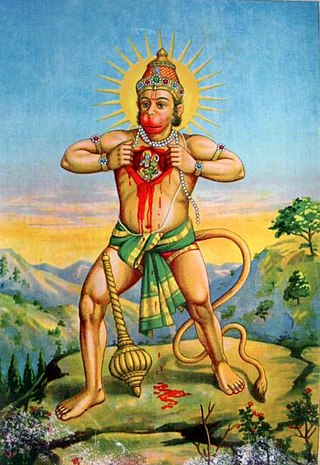
Hanuman, also known as Maruti, Bajrangabali, and Anjaneya, is a deity in Hinduism, revered as an avatar of Shiva, divine vanara, and a devoted companion of the deity Rama. Central to the Ramayana, Hanuman is celebrated for his unwavering devotion to Rama and is considered a chiranjivi. He is traditionally believed to be the spiritual offspring of the wind deity Vayu, who is said to have played a significant role in his birth. His tales are recounted not only in the Ramayana but also in the Mahabharata and various Puranas.

Sita, also known as Siya, Janaki, Maithili, Vaidehi and Bhumija, is a Hindu goddess and the female protagonist of the Hindu epic, Ramayana. She is the consort of Rama, the avatar of the god Vishnu, and is regarded as a form of Vishnu's consort, Lakshmi. She is also the chief goddess of Rama-centric Hindu traditions. Sita is known for her dedication, self-sacrifice, courage, and purity.

Sundara Kanda is the fifth book in the Hindu epic Ramayana. The original Sundara Kanda is in Sanskrit, and was composed in popular tradition by Valmiki, who was the first to scripturally record the Ramayana. Sundara Kanda is the only chapter of the Ramayana in which the principal protagonist is not Rama, but Hanuman. The work depicts the adventures of Hanuman and his selflessness, strength, and devotion to Rama are emphasised in the text. Hanuman is believed to have been fondly called “Sundara” by his mother Anjana, and Sage Valmiki is stated to have chosen this name over others as the Sundara Kanda is about Hanuman's journey to Lanka.

The Shiva Tandava Stotra(m) (Sanskrit: शिवताण्डवस्तोत्र, romanized: śiva-tāṇḍava-stotra) is a Sanskrit religious hymn (stotra) dedicated to the Hindu deity, Shiva, one of the principal gods in Hinduism and the supreme god in Shaivism. Its authorship is traditionally attributed to Ravana, the ruler of Lanka, considered a devotee of Shiva.

Ramayana: The Legend of Prince Rama is a 1992 anime film co-produced by Japan and India; produced and directed by Yugo Sako. It is based on the Indian epic Ramayana. The film was directed by Koichi Sasaki and Ram Mohan, with music composed by Vanraj Bhatia. Although it was banned in India during the Babri Masjid riots, it was later dubbed in Hindi and aired on DD National.
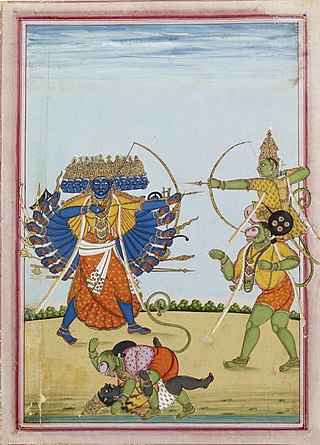
Depending on the methods of counting, as many as three hundred versions of the Indian Hindu epic poem, the Ramayana, are known to exist. The oldest version is generally recognized to be the Sanskrit version attributed to the sage Narada, the Mula Ramayana. Narada passed on the knowledge to Valmiki, who authored Valmiki Ramayana, the present oldest available version of Ramayana.
Ramayan is an Indian television series depicting the story of Rama and based on stories from classic Indian literature. The 2008 release is a reboot of the 1987 Ramayan television series of the same name. The plot derives from Valmiki's Ramayan, Tulsidas's Ramcharitmanas and Chakbasta's Urdu Ramayan with aspects of other works. The television series was produced by Sagar Arts and aired on NDTV Imagine. This Show Was Re-Aired On Dangal TV while the entire episodes of this show can be watched on Dangal Play app.
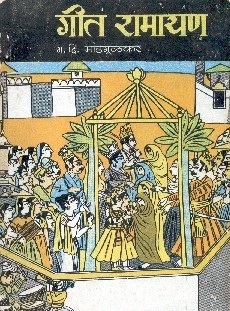
Geet Ramayan is a collection of 56 Marathi language songs chronologically describing events from the Indian Hindu epic, the Ramayana. It was broadcast by All India Radio, Pune in 1955–1956, four years before television was introduced in India. Written by G. D. Madgulkar and the songs being composed by Sudhir Phadke, Geet Ramayan was acclaimed for its lyrics, music and singing. It is considered a "milestone of Marathi light music" and the "most popular" Marathi version of Ramayana.

Ramayana: The Epic is a 2010 Indian Hindi-language computer-animated mythological action film from Maya Digital Media. Directed by Chetan Desai and produced by Ketan Mehta, it was released by Warner Bros. India on 15 October 2010.
The Adbhuta Ramayana is a Śāktaḥ Sanskrit work. It is considerably more obscure than both the Valmiki Ramayana as well as Tulsidas’ Awadhi version entitled Ramacharitamanasa, northern India's most popular version of the Ramayana story.
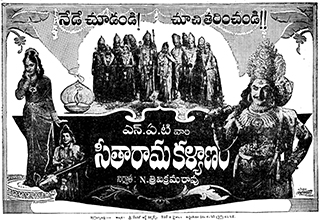
Sita Rama Kalyanam is a 1961 Indian Telugu-language Hindu mythological film directed by N. T. Rama Rao in his directorial debut. It stars N. T. Rama Rao, Haranath, Geetanjali, B. Saroja Devi, Kanta Rao, Sobhan Babu. The film was produced by N. Trivikrama Rao on 'National Art Theatres' banner. The music composed by Gali Penchala Narasimha Rao.

Lanka Dahan is a 1917 Indian silent film directed by Dadasaheb Phalke. Phalke also wrote the film based on an episode of the Hindu epic Ramayana, credited to Valmiki. The film was Phalke's second feature film after the 1913 Raja Harishchandra, which was the first Indian full-length feature film. Phalke also directed various short films in between.

In some adaptations of the Hindu epic Ramayana, Maya Sita or Chaya Sita is the illusionary duplicate of the goddess Sita, who is abducted by the demon-king Ravana of Lanka instead of the real Sita.

Trijata is a rakshasi (demoness) in the Hindu epic Ramayana who is assigned the duty of guarding Sita who was kidnapped by the demon-king of Lanka Ravana. In later adaptions of Ramayana, Trijata is described as a daughter of Vibhishana, the brother of Ravana.
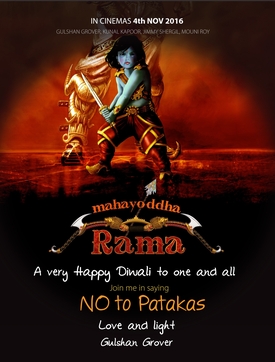
Mahayoddha Rama is a 2016 Indian Hindi-language animated film directed by Rohit Vaid. The film won the National Film Award for Best Animated Film. Mahayoddha Rama narrates the story of Ramayana from Ravan's perspective. The film had a delayed release in 2016.

















